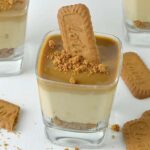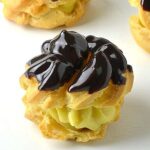
When selecting bakeware, think about the material. Metal pans conduct heat well. Glass retains it longer, sometimes unevenly. Ceramic provides a balance, while silicone offers flexibility and non-stick advantages. Size matters too: the right one guarantees no overflows and best results. Different shapes serve different dishes. Heavier pans offer even heat distribution, preventing burns. You’ll decide between non-stick and traditional types. The cool touch of silicone may entice you. Quality sets or individual pieces, your choice depends on your baking frequency. Delve deeper, and you’ll discover how to enhance your baking experience from oven to table.
Understanding Different Bakeware Materials
Before you immerse yourself in the world of baking, it’s important to grasp the various materials used in bakeware and how they can influence your culinary creations. For instance, metal pans, particularly those made of aluminum, are known for their exceptional heat conductivity. They’ll heat up quickly and evenly, ensuring your cakes or cookies bake uniformly. However, they’re prone to causing over-browning, especially if you’re not vigilant about your baking times.
On the other hand, glass bakeware retains heat for longer, which can keep your baked goods warm even after they’re out of the oven. Yet, their heat distribution isn’t as seamless as metal, which might lead to uneven baking. There’s also ceramic, which strikes a balance between heat retention and even distribution. It’s great for dishes that require slow, steady heat, like casseroles or pies.
Then there’s silicone, a non-stick, flexible material that stands up to high heat. It’s ideal for intricate molds, but may not hold shape well for heavier bakes. Each material has its unique benefits and drawbacks. Understanding these differences will help you select the right bakeware for your baking needs.
The Importance of Bakeware Size
Just as the material of your bakeware influences the outcome of your baked goods, the size of your pans and trays plays an equally vital role in the baking process. It’s not just about fitting your recipe into the pan; it’s about how your choice impacts heat distribution, cooking time, and the final appearance of your delicacy.
When you use a pan that’s too small, your battery might overflow, creating a messy oven and an unattractive final product. Conversely, a pan that’s too large could result in thin, overcooked baked goods. To find the golden middle, you need to pay attention to what the recipe calls for. If it specifies a certain size, there’s a good reason for it.
It’s also important to remember that different materials conduct heat differently. This means a larger metal pan may bake faster than a smaller ceramic one. So, while you’re considering the size of your bakeware, remember to factor in your knowledge of how different materials behave in the heat when you buy bakeware in the UAE.
Selecting the Right Bakeware Shape
Exploring the array of bakeware shapes available can feel like a challenging task, but understanding their unique purposes can help you select the perfect shape for every baking endeavor. From round cake pans to square baking dishes, the shape you choose can have a significant impact on the outcome of your baked goods.
Round bakeware is ideal for cakes and pies, allowing heat to distribute evenly for a consistent bake. Square and rectangular shapes are versatile, perfect for brownies, casseroles, and lasagnas where edge pieces are favored. Loaf pans, with their narrow and deep design, are best suited for bread and pound cakes, promoting an even rise and a beautifully domed top.
Choosing the right shape also depends on the recipe’s requirements. Delicate pastries, like tartlets, need shallow, fluted pans to support their structure, while deep-dish pies require a more substantial form to hold the filling.
The Role of Bakeware Thickness
After choosing the suitable shape for your baking needs, it’s equally important to ponder the thickness of your bakeware, another factor that can significantly impact your baking results. Bakeware thickness can influence several aspects of your baking process, including cooking time, temperature control, and even the color of your finished product.
The thickness of your bakeware plays a significant role in heat distribution. Thicker pans tend to distribute heat more evenly, reducing the chances of burnt or undercooked spots. However, they might require a slightly longer cooking time.
Here are some key points to ponder when contemplating bakeware thickness:
- Thinner bakeware heats up quicker, which can be advantageous for recipes that require a hot start, but they may overcook the edges of your baked goods.
- Thicker bakeware takes longer to heat, but once hot, they maintain the temperature more consistently, promoting even baking.
- An excessively thin bakeware can warp over time, especially under high heat.
Understanding the role of bakeware thickness in your baking outcome will help you select the right bakeware for your needs, enhancing your baking experience.
Nonstick Vs. Traditional Bakeware
When deciding between nonstick and traditional bakeware, it’s important to assess their unique characteristics and how they could impact your baking results. Nonstick bakeware, as the name suggests, is designed to prevent your baked goods from sticking to the pan’s surface, making for easy removal and clean-up. They’re ideal for delicate items like cookies, muffins, and cakes, where maintaining shape is essential.
However, they’re not invincible. Nonstick coatings can wear off over time, and they’re susceptible to scratches. Also, some nonstick pans can’t withstand high heat and may emit toxic fumes if overheated. So, you’ve got to treat them with care.
On the other hand, traditional bakeware – typically made from aluminum or stainless steel – may require more effort in terms of greasing and flouring to prevent sticking, but these pans are generally more durable. They can handle high temperatures, resist warping, and don’t carry the risk of nonstick coating wear.
The choice between nonstick and traditional bakeware ultimately depends on what you’re baking and your personal preferences. Both have their pros and cons, and understanding these will guide you in making a more informed purchase.
When to Choose Silicone Bakeware
In the world of baking, you’ll often find yourself at a crossroads, and opting for silicone bakeware could be a game-changer. Silicone bakeware is increasingly popular, offering unique advantages that can notably improve your baking experience. But when should you choose silicone over other options?
It’s primarily about what you’re baking and your personal preferences. Here are a few scenarios where silicone could be an excellent choice:
- You’re baking delicate or intricate items. Silicone’s flexibility makes it ideal for desserts like madeleines or Bundt cakes that can be hard to remove from traditional pans.
- You’re looking for easy cleanup. Silicone is naturally nonstick, so you won’t have to scrape or scrub.
- You value durability. Silicone is resistant to staining, warping, and melting, ensuring it lasts longer than many other materials.
The Benefit of Oven-to-Table Bakeware
Walking over to the domain of oven-to-table bakeware, you’ll discover the unparalleled convenience this type of bakeware brings to your culinary exploits. Oven-to-tableware is a multitasker’s dream, eliminating the need for multiple dishes and reducing clean-up time.
Imagine this: you’ve prepared a beautiful lasagna. With traditional bakeware, you’d have to transfer the hot, fragile dish to a serving platter before presenting it at the table—a risky task that could end in disaster. But, with oven-to-table bakeware, the dish you cook in is the dish you serve from. This not only streamlines the process but also enhances the presentation, adding a rustic, home-cooked appeal to your meals.
Moreover, oven-to-table bakeware is typically made of durable materials like stoneware or cast iron, which retain heat well. This means your dishes stay piping hot throughout the meal, enhancing both the taste and the overall dining experience. It’s a small difference that has a big impact.
In essence, investing in oven-to-table bakeware isn’t just about convenience—it’s about transforming your baking and dining experience. Now, aren’t you curious to explore this versatile world of bakeware?
Maintaining Your Bakewares Lifespan
Once you’ve selected your perfect oven-to-table bakeware, it’s equally important to know how to prolong its lifespan, ensuring it continues to serve up piping hot meals time after time. Proper maintenance is key, so let’s explore some effective strategies for keeping your bakeware in excellent condition.
Firstly, washing your bakeware correctly plays a significant role. Avoid using harsh scrubbing pads or steel wool, which can scratch and damage the surface. Instead, opt for soft sponges and gentle dish soap.
- Don’t let your bakeware sit in water for an extended time, as it may lead to rusting.
- Always dry your bakeware thoroughly before storing it. Moisture can encourage rust and shorten the lifespan of your pieces.
- Store your bakeware properly to avoid unnecessary scratches and dents.
Heat distribution is critical in baking, and a dented pan can lead to uneven baking. Bakeware maintenance isn’t just about aesthetics; it directly impacts the quality of your baked goods. By following these tips, you’ll be sure to get the most out of your bakeware, keeping your culinary creations delicious and your bakeware looking and performing its best.
Investing in Bakeware Sets Vs. Individual Pieces
While you’re pondering your bakeware choices, it’s crucial to consider whether investing in a full bakeware set or purchasing individual pieces will best fit your baking needs. If you’re a baking enthusiast or plan on doing a lot of baking, a set might be the best choice. It’s often more cost-effective and guarantees matching pieces that stack neatly, saving space.
However, if you’re a casual baker or have limited storage, individual pieces could be more practical. You can hand-pick pieces based on your specific needs, buying only what you’ll use. This prevents clutter and unnecessary expense.
It’s also worth considering the quality and versatility of the pieces. Sets may contain items you won’t use as much, but they’re generally made to a standard quality. On the other hand, buying individual pieces allows you to invest in high-quality items that you’ll use frequently.
Ultimately, the choice between bakeware sets and individual pieces depends on your baking habits, storage space, and budget. Evaluate your needs carefully, consider the pros and cons of each option, and then make an informed decision. After all, the right bakeware can greatly enhance your baking experience.
Conclusion
To sum up, selecting the right bakeware can be a piece of cake. It’s all about grasping materials, size, shape, and thickness. Consider the advantages and disadvantages of nonstick versus traditional, and don’t hesitate to choose silicone or oven-to-table options.
Take care of your bakeware properly, and it’ll reciprocate. Whether you choose sets or individual pieces, you’re making an investment in your culinary adventures. Happy baking





Leave a Reply